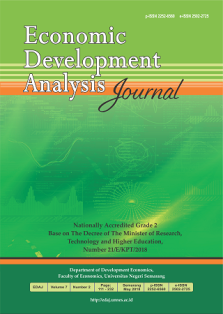ANALISIS KELAYAKAN USAHA DAN STRATEGI PENGEMBANGAN INDUSTRI KECIL BORDIR DI DESA PADURENAN KECAMATAN GEBOG KABUPATEN KUDUS
Keywords:
Embroidery, Feasibility Analysis, Strategy Development
Abstract
Kudus is a district with the smallest area, but from the industry and the potential market opportunities that can be relied upon. One type of potential small-scale industries located in District of Kudus is the embroidery industry. The village is a central Padurenan small industrial embroidery on Ghost district. Data analysis method used is descriptive analysis, feasibility feasibility analysis and SWOT analysis. Based on the calculation of the feasibility analysis of obtained results of the Net Present Value (NPV) of the embroidery industry in the small village of Padurenan Rp 27,915,942 the Benefit-Cost Ratio (BCR) of 1,72 and the Internal Rate of Return (IRR) of 22,34%. The conclusion to be drawn is that a small industry of embroidery in the Village District Gebog Padurenan of Kudus feasible. Advice can be given for small embroidery industry, product creativity needs to be improved in order to compete with the embroidery industry in other areas. You do this by holding a special trainingfor workers in the village Padurenan embroidery. Promotional embroidered products also need to be improved so that the market can be further expanded. You do this by following the promotion of fairs and word of mouth. The Government should continue to give support to small industries in the village embroidery Padurenan to overcome the limitations of capital, improve the quality and characteristics of products, to confront the threat of competition with small embroidery industry in other areas. You do this by providing both capital and conduct training to be more innovative embroidery designs
Published
2012-11-09
How to Cite
Trisnawati, A. (2012). ANALISIS KELAYAKAN USAHA DAN STRATEGI PENGEMBANGAN INDUSTRI KECIL BORDIR DI DESA PADURENAN KECAMATAN GEBOG KABUPATEN KUDUS. Economics Development Analysis Journal, 1(2). https://doi.org/10.15294/edaj.v1i2.469
Section
Articles


